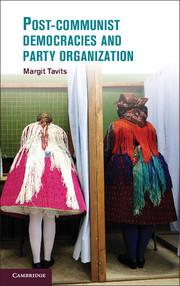6 - Environment, Ideology, and Leaders
Why Do Some Parties Have a Strong and Others a Weak Organization?
Published online by Cambridge University Press: 05 June 2013
Summary
The previous chapters have shown that parties in new democracies have contradictory incentives with regard to organization building. However, these contradictory incentives are present for all parties and it, therefore, remains unclear why some parties build strong organizations and others do not. The current chapter focuses on this very question – one that has received virtually no attention in the existing literature. A few studies have discussed the origins of organizational models and styles in the case of Western European party systems. However, the explanations provided do not appear to be very generalizable, especially to party systems under consideration here – those of new democracies – and are not necessarily helpful in explaining organizational strength. For example, Duverger (1954) and Panebianco (1988) have argued that the resources available at the time of parties’ inceptions and other factors resulting from historical path dependency influence organizational style. This explanation may help understand why, in advanced democracies, parties that were created at different times in history under different circumstances have evolved over the decades or centuries into organizations of diverging strength. However, the argument is not likely to apply in new democracies, where parties emerged relatively simultaneously, with all possessing relatively comparable resources and none being tied to any particular social cleavage. Other explanations refer to contextual factors such as the type of electoral system, party system, population density, and so forth, which operate on the national level (Harmel and Janda 1982; R. Katz 1980; Lowenberg and Patterson 1979; Tan 2000) and are therefore not able to account for differences across parties in the same country.
- Type
- Chapter
- Information
- Post-Communist Democracies and Party Organization , pp. 153 - 194Publisher: Cambridge University PressPrint publication year: 2013



